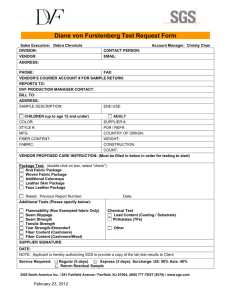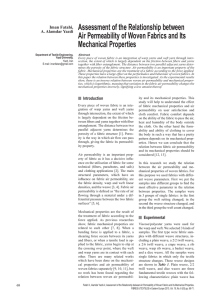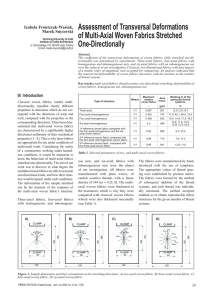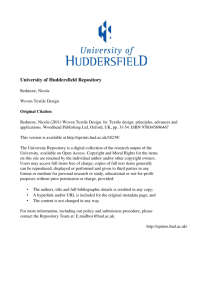2898 Demonstrate knowledge of woven fabric structure and
advertisement
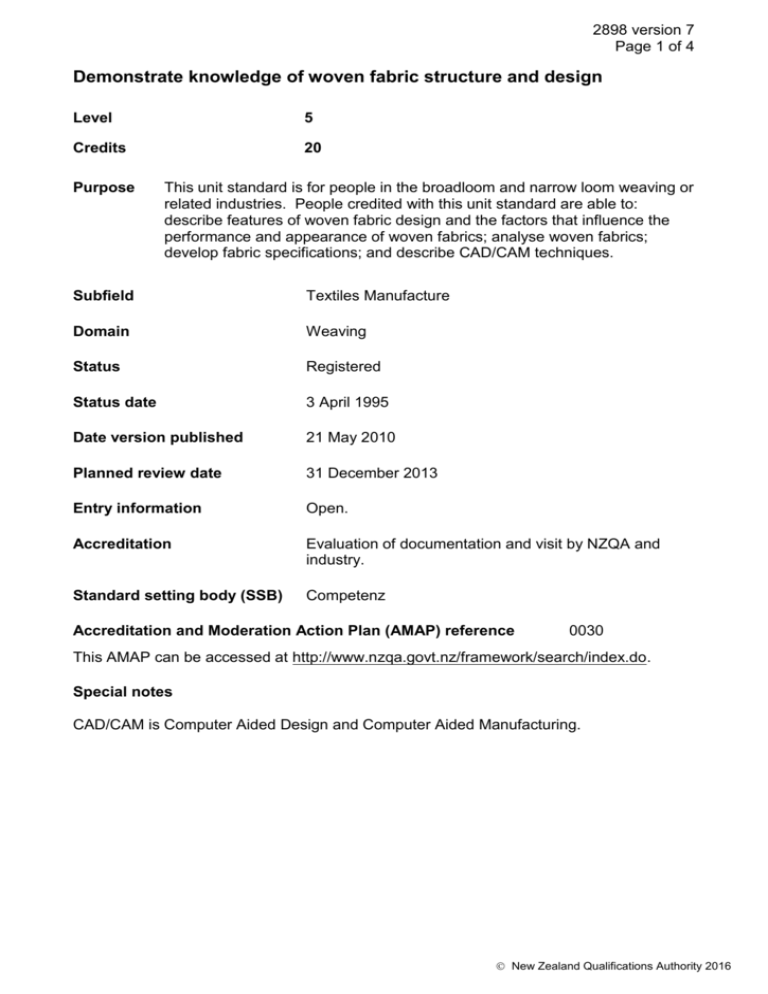
2898 version 7 Page 1 of 4 Demonstrate knowledge of woven fabric structure and design Level 5 Credits 20 Purpose This unit standard is for people in the broadloom and narrow loom weaving or related industries. People credited with this unit standard are able to: describe features of woven fabric design and the factors that influence the performance and appearance of woven fabrics; analyse woven fabrics; develop fabric specifications; and describe CAD/CAM techniques. Subfield Textiles Manufacture Domain Weaving Status Registered Status date 3 April 1995 Date version published 21 May 2010 Planned review date 31 December 2013 Entry information Open. Accreditation Evaluation of documentation and visit by NZQA and industry. Standard setting body (SSB) Competenz Accreditation and Moderation Action Plan (AMAP) reference 0030 This AMAP can be accessed at http://www.nzqa.govt.nz/framework/search/index.do. Special notes CAD/CAM is Computer Aided Design and Computer Aided Manufacturing. New Zealand Qualifications Authority 2016 2898 version 7 Page 2 of 4 Elements and performance criteria Element 1 Demonstrate knowledge of factors that influence the design, appearance and performance of woven fabrics. Performance criteria 1.1 Yarn properties are described in terms of their influence on fabric structure and design. Range 1.2 fibre components, count, twist level, twist direction, manufacturing method. Loom patterning devices are described and compared in terms of their operation and pattern capability. Range tappet, dobby, jacquard, and/or chain pattern, and/or drum pattern. 1.3 Cloth sett is defined and described, and the effects of balanced and unbalanced sett on fabric appearance and performance compared. 1.4 Compound weaves and their structure are described in terms of interlacing and point paper notation. Range two examples of pile weaves, two examples of flat weave. Element 2 Demonstrate knowledge of colour on fabric design. Performance criteria 2.1 Colour terms are defined and described. Range 2.2 Woven fabric factors that influence the colour appearance of the fabric are described. Range 2.3 spectrum, white light, absorption, reflection, primary colours, secondary colours, hue, complementary colours, contrast colours. fibre type, spinning system, weave, shadow effects, finishing processes, type of viewing light, reflection from surrounding objects. Colour and weave combinations are described in terms of effect and point paper notation. Range stripe, tartans, hounds tooth, shepherd, glen, birdseye. New Zealand Qualifications Authority 2016 2898 version 7 Page 3 of 4 Element 3 Prepare work instructions for woven fabric. Performance criteria 3.1 Warp and weft yarn requirements for standard fabrics are calculated from fabric design information. Range 3.2 fabrics – plain weave, twills, checks; yarn requirements – warp length, warp weight, weft weight, weft length. Work instructions are prepared to the standard required for use in the workplace. Range loom ticket or weaving ticket, weave plan, draft, peg plan, order of sleying or chain pattern. Element 4 Analyse woven fabric. Performance criteria 4.1 Features of woven fabric are identified to enable fabric analysis. Range 4.2 Specification of fabric is determined in terms of fabric variables. Range 4.3 face, back, warp direction, weft direction, bias, width. picks per cm, ends per cm, fabric weight, cloth sett, average float. Point paper notation documents weave and colour pattern of fabric. Element 5 Describe computer aided design and manufacturing (CAD/CAM) in relation to the design of woven fabrics. Performance criteria 5.1 Components of CAD/CAM systems are identified and their function described. Range 5.2 data storage, processor, input devices, display, printer and/or plotter. Methods of entering data into CAD/CAM systems are described and compared in terms of their advantages and disadvantages. Range keyboard, mouse, scanner, digitiser. New Zealand Qualifications Authority 2016 2898 version 7 Page 4 of 4 5.3 CAD/CAM and conventional design techniques are described and compared in terms of their advantages and disadvantages. 5.4 Maintenance and support for CAD/CAM systems are described. Range storage and retrieval of information, back-up and security requirements, methods of access to computerised design libraries. Please note Providers must be accredited by NZQA, or an inter-institutional body with delegated authority for quality assurance, before they can report credits from assessment against unit standards or deliver courses of study leading to that assessment. Industry Training Organisations must be accredited by NZQA before they can register credits from assessment against unit standards. Accredited providers and Industry Training Organisations assessing against unit standards must engage with the moderation system that applies to those standards. Accreditation requirements and an outline of the moderation system that applies to this standard are outlined in the Accreditation and Moderation Action Plan (AMAP). The AMAP also includes useful information about special requirements for organisations wishing to develop education and training programmes, such as minimum qualifications for tutors and assessors, and special resource requirements. Comments on this unit standard Please contact Competenz info@competenz.org.nz if you wish to suggest changes to the content of this unit standard. New Zealand Qualifications Authority 2016






